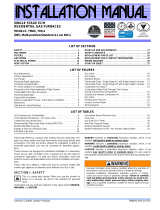
4
prior to performing the installation and operational
checkout of the equipment.
• Use caution when handling this appliance or removing
components. Personal injury can occur from sharp metal
edges present in all sheet metal constructed equipment.
• Do not store any of the following on, or in contact with,
the unit: Rags, brooms, vacuum cleaners, or other
cleaning tools, spray or aerosol cans, soap powders,
bleaches, waxes, cleaning compounds, plastics or plastic
containers, paper bags or other paper products, gasoline,
kerosene, cigarette lighter fluid, dry cleaning fluids, paint
thinners, or other volatile fluids.
• The installer should become familiar with the units wiring
diagram before making any electrical connections to the
unit. See
Figure 32 (page 38), Figure 33 (page 39), or
the unit wiring label.
• Always reinstall the doors on the furnace after
servicing. Do not operate the furnace without all doors
and covers in place.
REQUIREMENTS & CODES
WARNING:
The information listed below must be followed
during the installation, service, and operation
of this furnace. Failure to follow safety
recommendations could result in possible
damage to the equipment, serious personal
injury or death.
• This furnace must be installed in accordance with these
instructions, all applicable local building codes and the
current revision of the National Fuel Gas Code (NFPA54/
ANSI Z223.1) or the Natural Gas and Propane Installation
Code, CAN/CSA B149.1.
• Use only with type of gas approved for this furnace. Refer
to the furnace rating plate.
• Install this furnace only in a location and position as
specified on
page 5.
• Provide adequate combustion and ventilation air to the
furnace space as specified on
page 6, page 7,
page 8
& page 9.
• Provide adequate clearances around the vent air intake
terminal as shown in
Figure 7 (page 11), Figure 8 (page
11)
, Figure 9 (page 12), & Figure 10 (page 12).
• Combustion products must be discharged outdoors.
Connect this furnace to an approved vent system only,
as specified on
page 9, page 10, page 11, & page
12
.
• Never test for gas leaks with an open flame. Use
a commercially available soap solution to check all
connections. See
page 20.
• This furnace is designed to operate with a maximum
external pressure rise of 0.5 inches of water column.
Consult
Table 6 (page 32), Table 7 (page 33), Table 8
(page 34)
, Table 9 (page 36), & Table 10 (page 37)
and the rating plate for the proper circulating air flow and
temperature rise. It is important that the duct system be
designed to provide the correct flow rates and external
pressure rise. An improperly designed duct system can
result in nuisance shutdowns, and comfort or noise
issues.
• When supply ducts carry air circulated by the furnace
to areas outside the space containing the furnace, the
return air shall also be handled by duct(s) sealed to the
furnace casing and terminating in the conditioned space.
See
page 13 .
• A gas-fired furnace for installation in a residential garage
must be installed as specified on
page 5.
• This furnace is not approved for installation in mobile
homes. Installing this furnace in a mobile home could
cause fire, property damage, and/or personal injury.
• The Commonwealth of Massachusetts requires
compliance with regulation 248 CMR 4.00 and 5.00 for
installation of through – the – wall vented gas appliances
as follows:
1. For direct-vent appliances, mechanical-vent heating
appliances or domestic hot water equipment, where the
bottom of the vent terminal and the air intake is installed
below four feet above grade the following requirements
must be satisfied:
a.) A carbon monoxide (CO) detector and alarm shall be
placed on each floor level where there are bedrooms.
The detector shall comply with NFPA 720 (2005
Edition) and be mounted in the living area outside
the bedroom(s).
b.) A (CO) detector shall be located in the room that
houses the appliance or equipment and shall:
• Be powered by the same electrical circuit as the
appliance or equipment. Only one service switch
shall power the appliance and the (CO) detector;
• Have battery back-up power;
• Meet ANSI/UL 2034 Standards and comply with
NFPA 720 (2005 Edition); and Approved and listed
by a Nationally Recognized Testing Laboratory as
recognized under 527 CMR.
c.) A Product-approved vent terminal must be used,
and if applicable, a product-approved air intake must
be used. Installation shall be in strict compliance
with the manufacturer’s instructions. A copy of the
installation instructions shall remain with the appliance
or equipment at the completion of the installation.
d.) A metal or plastic identification plate shall be mounted
at the exterior of the building, four feet directly above
the location of vent terminal. The plate shall be of
sufficient size, easily read from a distance of eight
feet away, and read “Gas Vent Directly Below”.
2. For direct-vent appliances, mechanical-vent heating
appliances or domestic hot water equipment where the
bottom of the vent terminal and the air intake is installed
above four feet above grade the following requirements
must be satisfied:
a.) A (CO) detector and alarm shall be placed on each
floor level where there are bedrooms. The detector
shall comply with NFPA 720 (2005 Edition) and be
mounted in the living area outside the bedroom(s).
b.) The (CO) detector shall:
• Be located in the room that houses the appliance
or equipment;
• Be hard-wired or battery powered or both.
• Shall comply with NFPA 720 (2005 Edition).
c.) A product-approved vent terminal must be used,
and if applicable, a product-approved air intake must
be used. Installation shall be in strict compliance
with the manufacturer’s instructions. A copy of the
installation instructions shall remain with the appliance
or equipment at the completion of the installation.




















